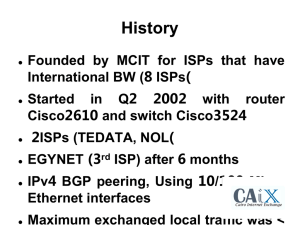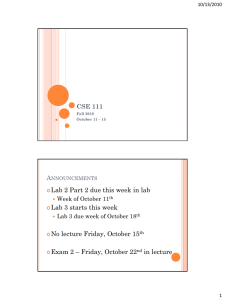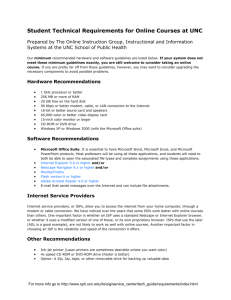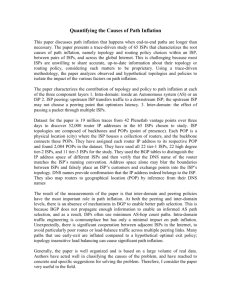On Cooperative Settlement Between Content, Transit and Eyeball ISPs Richard T.B. Ma
advertisement
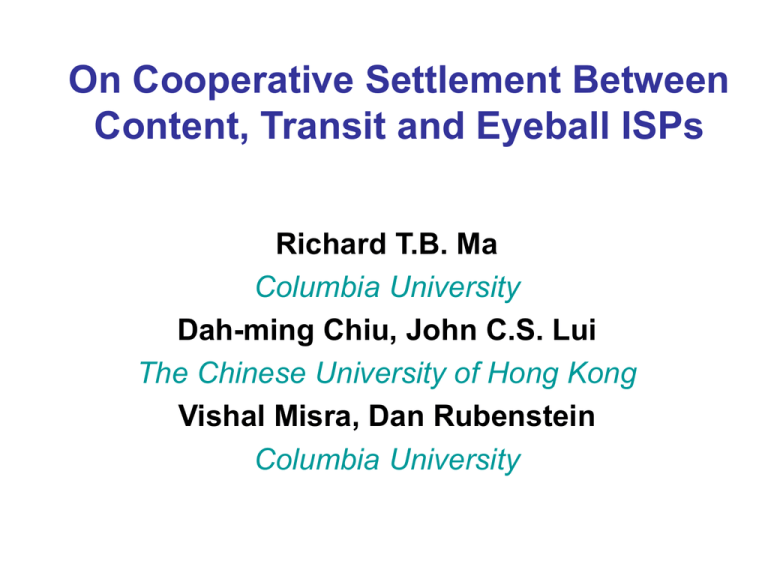
On Cooperative Settlement Between
Content, Transit and Eyeball ISPs
Richard T.B. Ma
Columbia University
Dah-ming Chiu, John C.S. Lui
The Chinese University of Hong Kong
Vishal Misra, Dan Rubenstein
Columbia University
Outline
• Current ISP Settlement Problems
• ISP Models
• Profit Sharing Among ISPs
• Implications
A view of Internet Service Providers (ISPs)
• The Internet is composed of
Autonomous Systems (ASes).
• An ISP is a business entity.
– Might comprise multiple ASes.
– Provide Internet access.
– Objective: maximize profits.
ISP
Different classes of ISPs
• Eyeball ISPs
– Provide Internet access to customers:
– Place Large investment in infrastructure.
– E.g. AT&T, Verizon …
• Content ISPs
– Provide contents via the Internet.
– Serve customers like:
• Transit ISPs
– Tier 1 ISPs: global connectivity of the Internet.
– Provide transit services for other ISPs.
– Cover a large geographic area.
Current ISP settlements
Customer-Provider Settlement
Zero-Dollar Peering Settlement
Transit ISP
Transit ISP
Transit ISP
Content ISP
Eyeball ISP
ISP positions on current settlement
Transit
Not enough revenue to recover investments.
Other ISPs are free-riding on our facilities.
Eyeball
Content Providers
Home-users’ monthly fees do not cover costs.
We should be able to generate more revenue.
We have paid our fair share for transit and
delivery and buy bandwidth from ISPs.
Issues of the current ISP settlements
Net Neutrality Debate: Provide Content-based Service Differentiation ?
Yes
No
Eyeball
Transit
Content Providers
Network Balkanization: De-peering between ISPs
Transit
Transit
zero-dollar peering
Level 3
Cogent
How to appropriately share profits amongst ISPs?
Contribution of this work
• Modeling of ISPs
– How the revenues are generated
– How different kinds of ISPs interact with one another
• Profit Sharing Solution Among ISPs
– Efficiency
– Fairness
– Uniqueness
• Implications on Bilateral Settlements
– Why the current settlements failed
– What kind of new settlements should emerge
The Network Model: Eyeball Side
r=$
• Geographic Regions (r)
• Per Customer Monthly Charge (ar)
a$
B1
US
B2
X$
• Customer Size (Xr)
r=£
• Eyeball ISP (Bj)
a₤
B2
UK
• Revenue from a region r (arXr)
B3
X₤
a$ X$+a₤ X₤
Eyeball Side Demand Assumption
US
• Elastic intra-region demand
– Customers can switch among ISPs
within a region.
– New eyeballs may take customers from
other eyeballs in the same region.
– Customers move to other eyeballs when
the original eyeball leaves the system.
• Inelastic inter-region demand
– Customers cannot switch to ISPs in
other regions.
– Constant customer size in a region.
B1
B2
B3
X$
UK
B3
X₤
The Network Model: Content Side
• Content Items (q)
{♫, ♣}
{♫}
• Content ISP (Ci)
b♫
• Per Customer Revenue
for content q (bq)
• Content-side Revenue
for uploading content q
to region r (bqXr)
C1
X$
{♣}
C2
b♣
{♫,♣}
C3
(b♫ +b♣)(X$+X₤)
X₤
a$ X$+a₤ X₤
How to share profits amongst ISPs?
How to share profit? -- the baseline case
b ♫ X$
{♫}
C1
US
a $ X$
B1
X$
• One content and one eyeball ISP.
• One region, US, and one content, ♫.
Profit generated: v=(a$+b♫)X$
• Egalitarian profit sharing:
1
j(B )=j(C ) = 2 v
How to share profit? -- multiple eyeballs
US
b ♫ X$
{♫}
B1
a $ X$
C1
B2
X$
• Symmetry: symmetric eyeball ISPs get the same profit.
• Efficiency: summation of all ISPs’ profit equals v.
Unique solution
j(C ) +2 j(B ) = v
(Shapley value)
2
j(C )= v
3
• Fairness: same mutual contribution for any pair of ISPs.
1
j(C ) - 2 v = j(B ) - 0
1
j(B )= 6 v
Properties of Shapley Value
The Shapley Value
Shapley 1953
Efficiency
Symmetry
Dummy
Additivity
Myerson 1977
Efficiency
Symmetry
Fairness
Symmetry
Strong Monotonicity
Young 1985
Efficiency
Shapley 1977
CoNEXT ‘07
Routing Incentive
Solution Stability
Interconnecting Incentive
How to share profit? -- multiple eyeballs
US
b ♫ X$
{♫}
B1
a $ X$
C1
B2
X$
n eyeball ISPs.
Bn
• The unique solution (Shapley value) that satisfies Efficiency
Symmetry and Fairness:
j(B )=
1
v, j(C ) = n v
n(n+1)
n+1
Results and implications of profit sharing
1
j(B )=
v, j(C ) = n v
n(n+1)
n+1
• The more eyeballs, the more profit the
content ISP gets.
US
{♫}
B1
C1
– Elastic users move between eyeball ISPs.
– Multiple eyeball ISPs provide redundancy;
– The only content ISP has more leverage.
Bn-1
n-1
v
• When one eyeball leaves the system: j’(C )=
n
• The marginal profit loss of the content ISP:
Dj(C )= n-1 v - n v = - 12 j(C )
n
n+1
n
– If n=1, the content ISP loses everything if the eyeball leaves.
– The content ISP loses only 1/n2 of its original profit.
Bn
How to share profit? -- multiple contents
{♫}
C1
{♫}
b ♫ X$
a $ X$
US
B1
C2
X$
{♫}
Cm
m content ISPs.
• The unique solution (Shapley value) that satisfies Efficiency
Symmetry and Fairness:
j(C )=
1
v, j(B ) = m v
m(m+1)
m+1
Results and implications of profit sharing
1
j(C )=
v, j(B ) = m v
m(m+1)
m+1
• The more contents, the more profit the
eyeball ISP gets.
– Content can be obtained by any content ISP.
– Multiple content ISPs provide redundancy;
– The only eyeball ISP has more leverage.
• The marginal profit loss of the eyeball ISP:
{♫}
C1
{♫}
US
B1
C2
{♫}
Cm
Dj(B )= - 12 j(B )
m
– If m=1, the eyeball ISP loses everything if the content leaves.
– The eyeball ISP loses only 1/m2 of its original profit.
Profit share -- multiple eyeballs and contents
{♫}
C1
US
B1
a $ X$
{♫}
b ♫ X$
B2
C2
X$
{♫}
Cm
Bn
• The unique solution (Shapley value) that satisfies Efficiency
Symmetry and Fairness:
m
n
j(B )=
v, j(C ) =
v
n(n+m)
m(n+m)
Results and implications of ISP profit sharing
C1
B1
C2
B2
Cm
Bn
m v
n v
j(B ) = n (n+m) , j(C ) = m (n+m)
• Each ISP’s profit is
– Inversely proportional to the
number of ISPs of its type.
– Proportional to the number of
ISPs of the opposite type.
• Intuition for elastic demand and supply
– The more of the same kind provide redundancy.
– The less of a kind can obtain more leverage.
Profit share -- eyeballs, transits and contents
{♫}
US
C1
T1
B1
a $ X$
{♫}
b ♫ X$
C2
T2
B2
X$
{♫}
Cm
Tk
m
k
n
k
m
n
v
j(B )=
S k=1
S
n+m+k m=1
v
j(C )=
S k=1
S
n+m+k n=1
v
j(T )=
S n=1
S
n+m+k m=1
Bn
m k
n+m+k-1
(m ) (k ) ( m+k )
n k
n+m+k-1
(n ) (k ) ( n+k )
m n
n+m+k-1
(m ) (n ) ( m+n )
Profit share -- eyeballs, transits and contents
• Intuition
– The more of the same kind provide redundancy.
– The less of a kind can obtain more leverage.
m
k
n
k
m
n
v
j(B )=
S k=1
S
n+m+k m=1
v
j(C )=
S k=1
S
n+m+k n=1
v
j(T )=
S n=1
S
n+m+k m=1
m k
n+m+k-1
(m ) (k ) ( m+k )
n k
n+m+k-1
(n ) (k ) ( n+k )
m n
n+m+k-1
(m ) (n ) ( m+n )
Profit share -- multiple regions and items
US
{♫}
C1
B1
T1
a $ X$
{♣}
(b♫ +b♣)
(X$+X₤)
C2
T2
UK
B2
a ₤ X₤
{♫,♣}
C2
T3
• Revenue sources are separable
X$
B3
X₤
a ₤ X₤
a $ X$
– Eyeball-side components:
– Content-side components: b♫X$ b♣X$ b♫X₤ b♣X₤
Profit share -- multiple regions and items
US
{♫}
C1
B1
T1
a $ X$
{♣}
(b♫ +b♣)
(X$+X₤)
b ♣X$
C2
T2
UK
B2
a ₤ X₤
{♫,♣}
C2
T3
X$
B3
X₤
• A specific revenue component is shared by
– Content ISPs that provide the item
– Eyeball ISPs that generate the revenue
– Transit ISPs that help the delivery
Profit share – general topologies
1
ji(N, v) =
[S ji(N \{j}, v) + v(N )1{i is veto}]
|N | j≠i
jC1 = 0
v = b♫ X$
{♫}
C1
US
C1
B1
T1
B2
T1
B2
C1 is Veto.
C1
B1
X$
jC1 = 1/3v
C1
B1
T1
B2
B1
jC1 = 1/3v
T1
B1
B2
C1
T1
Dynamic Programming Procedure!
5
1
1
1
jC1(N, v) =
[0 + v + v + v] =
v
12
3
3
4
B2
Implications – the value chain
B
C
T
$
CR
C1
$ $
$
$
B1
$
T2
T1
BR
$ $ $
B2
$ $ $
C2
$
C3
T4
$
T3
$
$ $
B2
$B
3
Implications – the value chain
B
C
T
C1
CR
$
T2
$ $
B1
T1
BR
$ $ $
B2
$ $ $
C2
T4
$
C3
T3
$ $
B2
B3
• Revenue Flows
– Content-side revenue (CR): Content Transit Eyeball
– Eyeball-side revenue (ER): Eyeball Transit Content
Implications – equivalent bilateral settlements
Customer
C
C1
CR
T
$ $
B1
T1
T4
$
BR
$ $ $
B2
Zero-dollar
Peering
C2
Customer
$
T2
$ $ $
C3
B
Provider
$ $
B2
T3
B3
• When CR ≈ BR, bilateral implementations:
– Customer/Provider: Contents & Eyeballs are customers.
– Zero-dollar Peering: Transit ISPs peer with each other.
– Stable structure for homogenous local ISPs 10 years ago.
Implications – equivalent bilateral settlements
CR
$ $ $
$ B
$
$ $
C
T
C1
$ $ $
$ $
$ $
T2
Customer
T1
$
B1
BR
Provider
B2
$ $ $
$ $ $
C2
Paid Peering
T4
$
C3
$ $
T3
B2
B3
• If CR >> BR, bilateral implementations:
– Reverse Customer/Provider: Transits compensate Eyeballs.
– Paid Peering: content-side compensate eyeball-side.
– New settlements are needed to sustain a stable structure.
Summary
• Content-Transit-Eyeball ISP model
– Customer demand, revenue generation.
– Closed-form Shapley value for regular topologies.
– Dynamic Programming for general topologies.
• Implications for current bilateral settlements
– Transit ISPs might need to compensate Eyeball ISPs,
which creates a Reverse Customer/Provider settlement.
– Paid Peering settlement might exist among Transit ISPs.
• Guideline for
– Government: make regulatory policy for the industry.
– ISPs: negotiate stable and incentive settlements.

